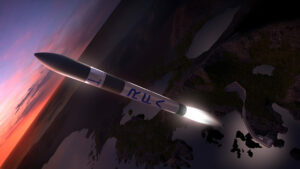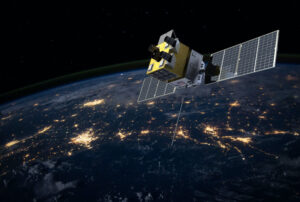Precious Payload partners with Arkisys, Rocket Factory Augsburg to market payload slots and launches
Thursday, 17 November 2022 16:54
Precious Payload has announced partnerships with a pair of companies to market payload slots and launches on its online satellite launch marketplace.
The post Precious Payload partners with Arkisys, Rocket Factory Augsburg to market payload slots and launches appeared first on SpaceNews.
Webb draws back curtain on Universe’s early galaxies
Thursday, 17 November 2022 14:00 Image:
Image:
The powerful NASA/ESA/CSA James Webb Space Telescope has found an unexpectedly rich ‘undiscovered country’ of early galaxies that has been largely hidden until now.
A few days after officially starting science operations, Webb propelled astronomers into a realm of early galaxies, previously hidden beyond the grasp of all other telescopes. Webb is now unveiling a very rich Universe where the first forming galaxies look remarkably different from the mature galaxies seen around us today.
Researchers have found two exceptionally bright galaxies that existed approximately 300 and 400 million years after the Big Bang. Their extreme brightness is puzzling to astronomers.
NOAA adopts Finland’s CubeSat-proven space weather monitor
Thursday, 17 November 2022 13:16
An advanced X-ray monitoring instrument tested for space aboard an ESA CubeSat will serve as an operational space weather payload on the US National Oceanic and Atmospheric Administration's Space Weather Next Lagrange 1 Series satellite, currently planned for launch in 2028, which will operate 1.5 million km from Earth, keeping watch for eruptions from our Sun.
Azure Orbital Space unveils software tools for space applications
Thursday, 17 November 2022 13:00
Microsoft announced the private preview Nov. 17 of a new product, the Azure Orbital Software Development Kit, the latest move by the software giant to play an important role role in the rapidly evolving space sector.
The post Azure Orbital Space unveils software tools for space applications appeared first on SpaceNews.
Strengthening InCubed’s role in commercial Earth observation
Thursday, 17 November 2022 13:00
Commercialisation is universally recognised as essential for the future prosperity of all aspects of the European space sector, and Earth observation is no exception. The ESA InCubed programme, a co-funding initiative that helps entrepreneurs bring their innovative ideas to market, has enjoyed enormous success since the launch of its first activity in 2018 and continues to make a prodigious contribution to commercial Earth observation. The InCubed portfolio includes around 60 activities, with an impressive €63 million invested so far.
At the upcoming ESA Council at Ministerial Level, Member States will have the possibility to further empower InCubed in its far-reaching efforts to
Spaceport Cornwall receives first U.K. spaceport license
Thursday, 17 November 2022 12:04
An English airport has secured the first-of-its-kind spaceport license from a British regulator that brings it one step closer to hosting the country’s first orbital launch.
NASA's Artemis I cameras to offer new views of Orion, Earth, Moon
Thursday, 17 November 2022 11:44 During Artemis I, NASA's Space Launch System (SLS) rocket will send the agency's Orion spacecraft on a trek 40,000 miles beyond the Moon before returning to Earth. To capture the journey, the rocket and spacecraft are equipped with cameras that will collect valuable engineering data and share a unique perspective of humanity's return to the Moon.
There are 24 cameras on the rocket and spac
During Artemis I, NASA's Space Launch System (SLS) rocket will send the agency's Orion spacecraft on a trek 40,000 miles beyond the Moon before returning to Earth. To capture the journey, the rocket and spacecraft are equipped with cameras that will collect valuable engineering data and share a unique perspective of humanity's return to the Moon.
There are 24 cameras on the rocket and spac Galactic Energy carries out fourth successful launch
Thursday, 17 November 2022 11:44 Galactic Energy, a private carrier rocket maker in Beijing, carried out the fourth flight mission of its CERES 1 rocket on Wednesday afternoon to deploy five Earth-observation satellites into orbit.
The CERES 1 Y4 rocket blasted off at 2:20 pm at Jiuquan Satellite Launch Center in northwestern China's Gobi Desert and soon placed the Gaofen 03D08, 03D51, 03D52, 03D53 and 03D54, five optical
Galactic Energy, a private carrier rocket maker in Beijing, carried out the fourth flight mission of its CERES 1 rocket on Wednesday afternoon to deploy five Earth-observation satellites into orbit.
The CERES 1 Y4 rocket blasted off at 2:20 pm at Jiuquan Satellite Launch Center in northwestern China's Gobi Desert and soon placed the Gaofen 03D08, 03D51, 03D52, 03D53 and 03D54, five optical LunIR joins CAPSTONE as 2nd Terran built Lunar satellite to launch this year
Thursday, 17 November 2022 11:44 Terran Orbital Corporation (NYSE: LLAP), a global leader in satellite-based solutions primarily serving the aerospace and defense industries, has announced the successful launch of LunIR. The Moon-mapping satellite is the second Terran Orbital-developed lunar satellite to launch this year - the first being CAPSTONE. Launched on June 28, CAPSTONE became the first satellite to enter a Near-Rectili
Terran Orbital Corporation (NYSE: LLAP), a global leader in satellite-based solutions primarily serving the aerospace and defense industries, has announced the successful launch of LunIR. The Moon-mapping satellite is the second Terran Orbital-developed lunar satellite to launch this year - the first being CAPSTONE. Launched on June 28, CAPSTONE became the first satellite to enter a Near-Rectili Rocket Factory Augsburg to use test infrastructure at DLR Lampoldshausen
Thursday, 17 November 2022 11:44 Space start-ups with micro-launcher projects will be important players in European space transport in the future. So-called micro-launchers are smaller rockets that can carry payloads of up to one tonne into low Earth orbit. They complement the capabilities of the established Ariane European launcher and will accelerate the development of new business areas and technologies in the launcher marke
Space start-ups with micro-launcher projects will be important players in European space transport in the future. So-called micro-launchers are smaller rockets that can carry payloads of up to one tonne into low Earth orbit. They complement the capabilities of the established Ariane European launcher and will accelerate the development of new business areas and technologies in the launcher marke Try, Try Again: Sols 3655-3656
Thursday, 17 November 2022 11:44 Yesterday we weren't able to use the arm and thus weren't able to do contact science, but a short drive got us into a better position. Unfortunately, the dust removal tool still wasn't safe to use at our location, so the team decided to make another drive to try again for contact science on the weekend. Even though the plan wasn't what we expected coming in to today, we were still able to make t
Yesterday we weren't able to use the arm and thus weren't able to do contact science, but a short drive got us into a better position. Unfortunately, the dust removal tool still wasn't safe to use at our location, so the team decided to make another drive to try again for contact science on the weekend. Even though the plan wasn't what we expected coming in to today, we were still able to make t Space exploration goes underground
Thursday, 17 November 2022 11:44 Is there life in Martian caves? It's a good question, but it's not the right question-yet. An international collaboration of scientists led by NAU researcher Jut Wynne has dozens of questions we need asked and answered. Once we figure out how to study caves on the Moon, Mars and other planetary bodies, then we can return to that question.
Wynne, an assistant research professor of cave ecol
Is there life in Martian caves? It's a good question, but it's not the right question-yet. An international collaboration of scientists led by NAU researcher Jut Wynne has dozens of questions we need asked and answered. Once we figure out how to study caves on the Moon, Mars and other planetary bodies, then we can return to that question.
Wynne, an assistant research professor of cave ecol NASA Awards SpaceX Second Contract Option for Artemis Moon Landing
Thursday, 17 November 2022 11:44 NASA has awarded a contract modification to SpaceX to further develop its Starship human landing system to meet agency requirements for long-term human exploration of the Moon under Artemis.
With this addition, SpaceX will provide a second crewed landing demonstration mission in 2027 as part of NASA's Artemis IV mission.
"Returning astronauts to the Moon to learn, live, and work is a
NASA has awarded a contract modification to SpaceX to further develop its Starship human landing system to meet agency requirements for long-term human exploration of the Moon under Artemis.
With this addition, SpaceX will provide a second crewed landing demonstration mission in 2027 as part of NASA's Artemis IV mission.
"Returning astronauts to the Moon to learn, live, and work is a Artemis I captures new images of Earth, the moon and Orion spacecraft
Thursday, 17 November 2022 11:44 Cameras on board NASA's Artemis I began capturing images Wednesday with new views of Earth, the moon and the Orion spacecraft.
After several delays Artemis I blasted off early Wednesday morning from the Kennedy Space Center in Cape Canaveral, Fla. Before returning to Earth, NASA's Artemis I will travel 40,000 miles beyond the moon collecting engineering data.
Four of the 24 camer
Cameras on board NASA's Artemis I began capturing images Wednesday with new views of Earth, the moon and the Orion spacecraft.
After several delays Artemis I blasted off early Wednesday morning from the Kennedy Space Center in Cape Canaveral, Fla. Before returning to Earth, NASA's Artemis I will travel 40,000 miles beyond the moon collecting engineering data.
Four of the 24 camer Looking to Artemis I for a return to the moon
Thursday, 17 November 2022 11:44 On Nov. 16, NASA successfully launched the Artemis I mission after several launch delays. Artemis I is an uncrewed test flight featuring a Space Launch System (SLS) rocket that will send the Orion spacecraft around the moon and back to test the system and hardware extensively before future flights with astronauts.
The first of several missions, Artemis I will pave the way for subsequent mi
On Nov. 16, NASA successfully launched the Artemis I mission after several launch delays. Artemis I is an uncrewed test flight featuring a Space Launch System (SLS) rocket that will send the Orion spacecraft around the moon and back to test the system and hardware extensively before future flights with astronauts.
The first of several missions, Artemis I will pave the way for subsequent mi 
